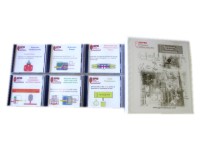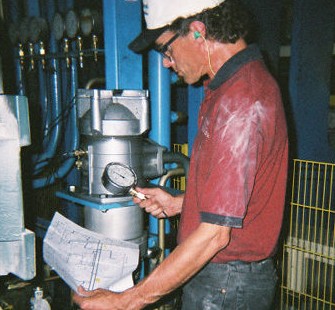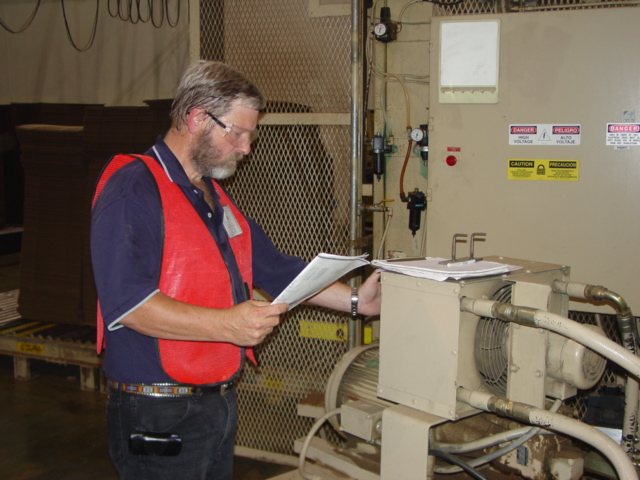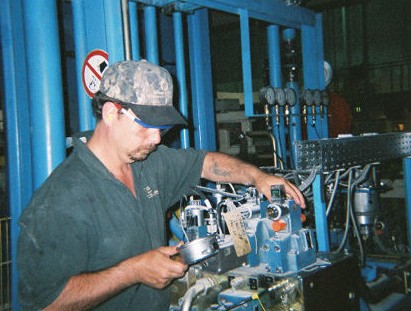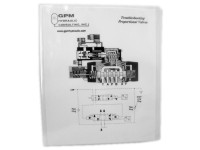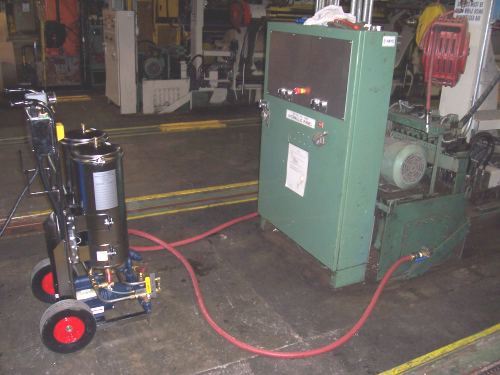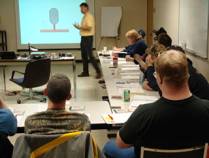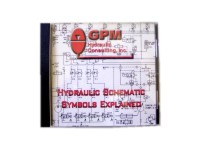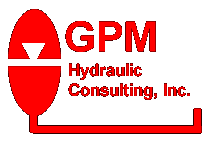
P.O. Box 1376 Monroe, GA 30656 (770) 267-3787 gpm@gpmhydraulic.com
|
September
2008
For an archive of past newsletters, please visit: |
|||||||||||||||||||||
|
CLICK HERE to send this newsletter to a friend! |
||||||||||||||||||||||
|
||||||||||||||||||||||
|
|
||||||||||||||||||||||
|
|
Maintenance Hydraulic Troubleshooting on Interactive CD Our nationally acclaimed
Maintenance Hydraulic Troubleshooting workshop
on six fully interactive CD's. Includes our MHT workshop manual.
6-CD Set - $1200 Individual CD's - $250
+ Shipping and Handling.
Click on http://gpmhydraulic.com/mhtcds.htm
to find out more.
|
|||||||||||||||||||||
| 1. Case of the $96,000 Pipe Plugs | ||||||||||||||||||||||
 Jack
Weeks - Consultant for GPM Hydraulic Consulting, Inc Jack
Weeks - Consultant for GPM Hydraulic Consulting, Inc |
||||||||||||||||||||||
|
Recently after we taught a Troubleshooting Proportional
Valves one-day workshop, a student told us about a problem at his plant that
cost over $96,000.00. He said that a cylinder with a Temposonic
transducer had simply stopped functioning. Most of the techs agreed
that the problem was likely to be the proportional valve that controlled the
circuit, so he changed the proportional valve, replacing it with one with
exactly the same part number as the original. The problem was not
solved, so several other components were replaced, including the valve
amplifier power supply, the transducer and even the pump. He said,
"Had I known what I learned today six months ago, I could have saved my
plant 8 hours of downtime. Downtime costs on that particular machine
are over $12,000 an hour!" That's $96,000.00 PLUS the cost of the
unnecessary components that were changed. The particular valuable
piece of information he had learned that day was that there were two small
threaded plugs in that valve that had to be removed before installing it on
the machine.
The valve in question is known as a two-stage type proportional valve (see Figure 1). It requires both electrical power and hydraulic pressure to operate. The purpose of the pilot valve (the smaller valve located on top) is to direct pilot pressure to shift the much larger main valve spool. This pilot pressure can come from either an internal passage in the valve or from an external pilot source. Approximately 118 PSI is required to overcome the spring force shift this particular main valve spool. Notice that in the schematic in Figure 2 the pilot pressure plug is located between the inlet line of the main valve and the pressure port of the pilot valve. When the plug is installed, pilot pressure must be provided from an external source and supplied to the "X" port. Once the pilot valve spool is shifted to the straight ("A" position) or crossed arrows ("B" position), oil will be directed to one end of the valve spool. Usually a separate pump system with a maximum pressure of about 200 PSI is used to supply pilot fluid. Another common method is to use a pressure reducing valve from the main pump line to supply oil to the "X" port. Using a lower pressure for pilot fluid saves a lot of shock and wear on the valve, greatly extending its life expectancy.
Figure 1
Figure 2 In the cutaway shown in Figure 3, the pilot plug is located in an internal passage inside the main spool housing. If there is no pilot oil connected to the “X” port then the main spool will not move when the pilot valve spool is shifted . This means that the valve must be converted from an externally to internally piloted valve. This is done by removing the pilot valve and removing the threaded plug. The plugs are usually metric so metric allen wrenches will be required. Removing the plug hydraulically connects the oil at the “P” port of the main spool, through the valve body, to the “P” port of the pilot valve.
Figure 3
Figure 4
Figure 5 If there is no line connected from the “Y” port of the valve back to the tank, then the main spool will not shift. To convert the valve from an external to an internal pilot, the drain line plug must be taken out. The pilot valve must be removed to access the drain plug (Figure 5). The oil that exhausts out of one end of the main spool can then flow through the pilot valve and back into the internal tank passage of the main spool.
Figure 6 Another problem can occur when sending the original valve back for repair. When the valve is received at the repair shop guess what the technician does to the valve? If the part number designates that the valve is externally pilot and drained, the pipe plugs are installed back in the valve! To prevent this from occurring at your plant, there are two options: First, order the valve with the part number that indicates the valve is internally piloted and drained (plugs removed). The second option, is to make sure everyone in the maintenance department knows to remove the pipe plugs prior to installation. Option no. 1 is far better because the human factor is removed from the equation. |
||||||||||||||||||||||
| Jack Weeks entered GPM’s organization in January of 1997 as a CAD draftsman and hydraulic instructor. He has trained thousands of electricians and mechanics in Hydraulic Troubleshooting methods. His computerized animations have made GPM's presentations and training CD's the recognized leader in the industry. He received his education from the Georgia Institute of Technology School of Electrical Engineering and the Department of State Foreign Service Institute. Jack is an experienced draftsman and taught telecommunications equipment operation and repair for the Central Intelligence Agency at American embassies overseas. | ||||||||||||||||||||||
|
2. In-plant consulting and troubleshooting
Nothing is more expensive than unscheduled down time. GPM’s customers know they can call whenever they have a troubleshooting issue they simply can’t resolve. With over 50 years experience dealing with hydraulic failures, our consultants have the resources to help troubleshoot whatever hydraulic problem you encounter. Whether you’re experiencing a total system outage, repeated component failure or just need a professionally designed preventive maintenance schedule, the consultants at GPM can help. Call GPM for In-plant Troubleshooting Leakage Problems Pressure Settings Shock Problems Preventive
Maintenance Scheduling Hydraulic Troubleshooting Manual Development Startup
Consulting and Recommendations Heat
Problems Repeated
Component Failures Speed Problems Do you want to learn more on how GPM can help you? Go to http://gpmhydraulic.com/troubleshooting.htm
|
||||||||||||||||||||||
|
|
Troubleshooting Proportional Valves The complete guide to troubleshooting and maintaining linear positioner circuits with electronically controlled proportional valves. The same manual used in our acclaimed Troubleshooting Proportional Valves public seminar. $49.95 + Shipping & Handling To order this and other exciting products online, visit the GPM Store!
|
|||||||||||||||||||||
|
3. When Can We Expect Hydraulic Oil To Get Cheaper? You may or may not have noticed that hydraulic oil prices have skyrocketed. It has been all we can do to keep our PowerPoint files up to date when we discuss in class how much a leak costs. The last quote we got? Hold onto your hats - $20 a gallon for some oils! Most oil is less than that of course, but not by much. Why is it so expensive? When will the price come down? The bad news is, it's probably not. We heard recently that the United States alone consumes over 882 tons of oil per day. This is about a fourth of the world's consumption, which means that total consumption is four times that amount. By some estimates, this means that the total world supply of oil will be depleted in about 40 years at this rate. We aren't sure how accurate that deadline might be, but one thing we can be pretty sure of is that we can't expect any of our vendors to be running clearance sales any time soon. Add to that the recent refinery damage from hurricane Ike and we can easily expect higher prices in the short term, not lower ones. There has never been a better time to start working a little harder to extend the life span of the oil in your machines. Summer is coming - get a handle on those heat problems! Nothing shortens the life span of oil like high temperatures. And reclaiming the oil in your machines instead of replacing it begins to look more and more cost effective all of the time. We've done the research and have found the most effective flushing machine for its cost.
We can provide flushing machines for mineral oil, water glycol systems and fuel oil as well. If you're concerned about the cost of oil and would like to learn more about reclaiming it instead of replacing it, call us right away at (770) 267-3787 or email us at gpm@gpmhydraulic.com |
||||||||||||||||||||||
|
|
||||||||||||||||||||||
|
Maintenance Hydraulic Troubleshooting 2008 3 Day Course Registration Fee $850.00 Per Person Learn More About Our Maintenance Hydraulic Troubleshooting Course
*2009 Calendar Will Be Available Soon - Call If You Would Like To See A Workshop Scheduled In Your Area! |
||||||||||||||||||||||
|
If you've found our newsletter informative and beneficial please click here to tell your co-workers and friends.
|
||||||||||||||||||||||
|
|
Hydraulic Schematic Symbols Explained This interactive CD is the fastest, easiest way available to learn hydraulic schematic symbols.$49.95 + Shipping & Handling. Find out more, go to http://gpmhydraulic.com/symbolcd.htm
|
|||||||||||||||||||||
|
Site Index [Home] [Our Training] [Hydraulic Consulting] [Our People] [Hydraulics Quiz] [Upcoming Events] [Contact Us] GPM Hydraulic Consulting, Inc. Box 1376 Monroe, GA 30655 (770) 267-3787 |
||||||||||||||||||||||


